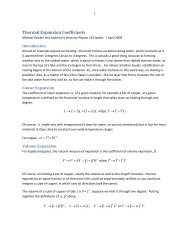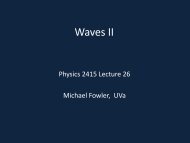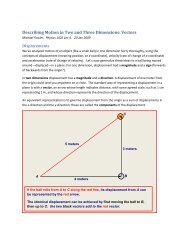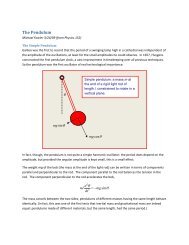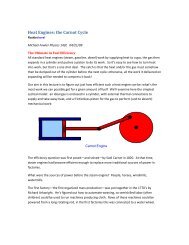Kinetic Theory of Gases - Galileo and Einstein
Kinetic Theory of Gases - Galileo and Einstein
Kinetic Theory of Gases - Galileo and Einstein
You also want an ePaper? Increase the reach of your titles
YUMPU automatically turns print PDFs into web optimized ePapers that Google loves.
<strong>Kinetic</strong> <strong>Theory</strong> <strong>of</strong> <strong>Gases</strong><br />
Physics 1425 Lecture 31<br />
Michael Fowler, UVa
Bernoulli’s Picture<br />
• Daniel Bernoulli, in 1738, was<br />
the first to underst<strong>and</strong> air<br />
pressure in terms <strong>of</strong> molecules—<br />
he visualized them shooting<br />
around very rapidly in a closed<br />
container, supporting a weight<br />
as shown by constantly bouncing<br />
<strong>of</strong>f the underside <strong>of</strong> the piston.<br />
• Given more room, they would<br />
rush in to fill the new space, just<br />
as a gas is observed to do.<br />
• No-one believed him.<br />
Applet here.
One Dimensional, One Molecule Gas<br />
• The molecule roundtrips in time<br />
2L/v, so it bounces <strong>of</strong>f the piston<br />
v/2L times per sec, each time<br />
delivering momentum 2mv, so the<br />
piston will pick up momentum from<br />
this “gas” at rate 2mv x v/2L per<br />
second.<br />
• Force from gas on piston:<br />
F = rate <strong>of</strong> change <strong>of</strong> momentum =<br />
mv 2 /L. An equal opposite force must<br />
be supplied from outside to keep the<br />
piston at rest.<br />
• Animation!<br />
• V<br />
v<br />
1-D gas: molecule bounces<br />
between ends <strong>of</strong> cylinder.<br />
L
Molecule in a Two-Dimensional Box<br />
• Assume perfectly elastic<br />
collisions with all walls.<br />
• The molecule will follow a<br />
zigzag path, the time between<br />
collisions with the same end,<br />
say the end at x = L, is now<br />
2L/v x , <strong>and</strong> the momentum<br />
transferred per collision is<br />
2mv x , so the average force on<br />
the end is mv x2 /L.<br />
• This will still hold good in three<br />
dimensions.<br />
• a<br />
y<br />
v y<br />
v x<br />
0 x<br />
L
N Molecules in an L x L x L Cube<br />
• Assume first that we have a very large number<br />
N <strong>of</strong> molecules bouncing around, so small that<br />
they don’t hit each other, each follows its own<br />
zigzag path.<br />
• The force on the right-h<strong>and</strong> wall at x = L is just<br />
the sum <strong>of</strong> the forces from each one, so<br />
• F = mv x12 /L +mv x22 /L +mv x32 /L + … + mv xN2 /L .
Bar Means Average<br />
• The force on the wall depends on the sum<br />
2 2 2 2<br />
vx 1+ vx2 + vx3+ +<br />
vxN<br />
• We don’t need the individual values v x12 , etc.,<br />
just the average, written with a bar:<br />
v<br />
v + v + v + +<br />
v<br />
N<br />
2 2 2 2<br />
2<br />
x<br />
=<br />
x1 x2 x3<br />
xN<br />
• So the force on the wall is:<br />
F<br />
=<br />
2<br />
Nmv x<br />
L
Gas Molecules Have R<strong>and</strong>om Velocities…<br />
• Gravity has a negligible effect on the speeds, so<br />
all directions look the same to the gas<br />
molecules.<br />
2 2 2<br />
• This means: vx = vy = vz<br />
<strong>and</strong> since the molecular speed squared<br />
it follows that<br />
v = v + v + v<br />
2 2 2 2<br />
x y z<br />
v<br />
=<br />
v<br />
2 1 2<br />
x 3
Relating Pressure to Molecular Energy<br />
• Our gas <strong>of</strong> molecules is in an L x L x L cube, the force on<br />
one wall (which has area L 2 ) is<br />
F<br />
Nmv<br />
= =<br />
L<br />
Nmv<br />
3L<br />
2 2<br />
x<br />
• So the pressure P, force per unit area, is (V = L 3 )<br />
2<br />
F Nmv<br />
= = =<br />
2N<br />
P L<br />
2 3<br />
3 L 3 V<br />
• Now we’ll multiply both sides by V …<br />
( )<br />
1 2<br />
2<br />
mv
Finding the Ideal Gas Law<br />
( )<br />
2 1 2<br />
• We’ve established that PV =<br />
3N 2mv<br />
<strong>and</strong> we know that for very weakly interacting gases,<br />
PV = nRT. These two equations must be the same!<br />
• The equivalence is most simply expressed using<br />
Boltzmann’s constant, k = R/N A (= 1.38 x 10 -23 J/K).<br />
PV =nRT = nN A kT = NkT, so<br />
mv<br />
=<br />
1 2 3<br />
2 2<br />
kT<br />
• Absolute temperature is proportional to average<br />
molecular kinetic energy.
Average Speed <strong>of</strong> Air Molecules<br />
• Maxwell <strong>and</strong> co were very smart guys—they<br />
figured out accurately the average speed <strong>of</strong> air<br />
molecules before they had any idea how big the<br />
molecules were!<br />
• They just used<br />
( )<br />
PV = N mv = Nmv = M v<br />
2 1 2 1 2 1 2<br />
3 2 3 3<br />
where M is the total mass <strong>of</strong> the gas in the box.
Average Speed <strong>of</strong> Air Molecules<br />
1 2<br />
• Let’s see what PV =<br />
3<br />
M v gives for the speed <strong>of</strong><br />
air molecules in this room (we are, <strong>of</strong> course,<br />
averaging here over oxygen <strong>and</strong> nitrogen plus a<br />
tiny amount <strong>of</strong> other stuff).<br />
• Let’s take a one meter cube: it will contain about<br />
1.3 kg <strong>of</strong> air. The pressure P = 10 5 N/m 2 , close<br />
enough, so<br />
5 1 2<br />
PV = 10 =<br />
3<br />
(1.3) v<br />
2<br />
giving the root mean square value v = 480 m/s.
Clicker Question<br />
• Since oxygen, nitrogen <strong>and</strong> helium all satisfy<br />
the same gas law PV = nRT at room<br />
temperature, we conclude that:<br />
A. All have the same (rms) root mean square<br />
average molecular speed<br />
B. All have the same average molecular kinetic<br />
energy<br />
C. Neither <strong>of</strong> the above is true.
Clicker Question<br />
• If we take the average speed <strong>of</strong> oxygen<br />
molecules in this room to be 480 m/s, what<br />
would be the average speed <strong>of</strong> helium atoms<br />
that leaked from a balloon into the room?<br />
A. 480 m/s<br />
B. 960 m/s<br />
C. 1360 m/s<br />
D. 1920 m/s
The Speed Distribution<br />
• Although the molecules fly freely almost all <strong>of</strong><br />
the time, they do collide occasionally.<br />
• Assuming r<strong>and</strong>om elastic collisions, there will<br />
be transfer <strong>of</strong> energy, typically <strong>of</strong> order kT,<br />
from one to another in a collision.<br />
• The chances <strong>of</strong> a particular molecule picking<br />
up kT n times in a row is similar to the chances<br />
<strong>of</strong> a coin toss coming up heads n times in a<br />
row…. that is, high energies are exponentially<br />
unlikely.
Maxwell’s Speed Distribution<br />
• Maxwell did the math precisely, <strong>and</strong> found the<br />
probability <strong>of</strong> a molecule having a high energy at a<br />
given moment did drop exponentially with energy:<br />
Probability (speed = v)<br />
∝<br />
e −<br />
1 2<br />
mv /<br />
2<br />
kT<br />
meaning that for each extra kT <strong>of</strong> energy, the<br />
probability <strong>of</strong> finding a particle with that energy<br />
drops by 1/e ≈ 0.37 —more than a factor <strong>of</strong> 2,<br />
because the average amount picked up per collision is<br />
less that kT.<br />
1<br />
2 − mv / kT<br />
2<br />
• (Maxwell’s exact result is f v = 4π<br />
N⎜ ⎟ ve .)<br />
2π<br />
( )<br />
⎛<br />
⎝<br />
m ⎞<br />
kT ⎠<br />
3<br />
2<br />
2
Escaping from a Planet<br />
• Maxwell’s speed distribution makes it quite easy<br />
to predict which gases can escape from planetary<br />
atmospheres.<br />
• For the Earth, v escape = 11 km/sec.<br />
• The upper atmosphere has parts as hot as 1000K.<br />
2<br />
−mv<br />
kT 3 escape /2<br />
• The speed distribution includes e = e −<br />
1 2 3<br />
where we’ve used 2mv<br />
=<br />
2kT.<br />
• For H 2 , at 1000K, the fraction <strong>of</strong> molecules at<br />
escape velocity is <strong>of</strong> order 10 -6 , for He 10 -12 , for<br />
O 2 10 -79 . This means the H 2 will escape almost<br />
instantly, the He pretty quickly, <strong>and</strong> the O 2 never.<br />
2 2<br />
/2 v v
Clicker Question<br />
• Which <strong>of</strong> the following gases would you expect<br />
to be dominant in the Martian atmosphere?<br />
A. H 2<br />
B. He<br />
C. N 2<br />
D. H 2 0<br />
E. CO 2
Real <strong>Gases</strong><br />
• (This is <strong>of</strong> course chemistry.)<br />
• Water has the three phases<br />
as shown on this pressure/<br />
temperature graph.<br />
• They meet at the “triple<br />
point” a definite P <strong>and</strong> T,<br />
useful as a reference point<br />
in fixing temperatures.<br />
• Freezing <strong>and</strong> boiling points<br />
vary with pressure.<br />
• At the critical point, liquid<br />
<strong>and</strong> vapor become the<br />
same.<br />
The solid-liquid dividing line slopes<br />
forwards for almost all substances—<br />
water is an exception.
Vapor Pressure <strong>and</strong> Humidity<br />
• The H 2 O molecules in liquid water strongly<br />
attract each other, holding the liquid together.<br />
But these molecules are still jiggling around,<br />
with a Maxwell speed distribution. This means<br />
a fraction <strong>of</strong> them near the surface are moving<br />
fast enough to escape, forming a vapor above<br />
the surface.<br />
• In a closed container, with enough water<br />
present, an equilibrium situation is reached<br />
between escaping <strong>and</strong> returning molecules.
Water <strong>and</strong> Vapor in Equilibrium<br />
• In equilibrium in a closed container,<br />
the molecules in the vapor have the<br />
same average kinetic energy as the<br />
air molecules, so exert pressure on<br />
the walls <strong>of</strong> the container<br />
proportionate to their numbers.<br />
• This is the saturated vapor<br />
pressure. It varies with temperature<br />
like e −a/T , not surprising since its<br />
origin is molecules fast enough to<br />
escape.<br />
• a<br />
Air + water vapor<br />
Water
Water Vapor Pressure<br />
• At room temperature, saturated vapor pressure<br />
is about 2.5% <strong>of</strong> atmospheric pressure.<br />
• At 100°C, it equals atmospheric pressure: this<br />
means small bubbles formed in the liquid by<br />
fast moving molecules coming together are no<br />
longer crushed by the surrounding atmospheric<br />
pressure, the water boils.<br />
• In mountain resorts like Aspen, water boils at a<br />
lower temperature, producing inferior tea.
Relative Humidity <strong>and</strong> Dew Point<br />
• If water is constantly boiled <strong>of</strong>f in a closed<br />
room, it is not possible to establish an<br />
equilibrium situation with vapor pressure<br />
above the saturated value for that temperature<br />
—further water will condense out on the walls,<br />
etc. At this point, relative humidity = 100%.<br />
• Relative humidity =<br />
vapor pressure/saturated vapor pressure<br />
Dew point: temperature at which dew forms—<br />
that is, water condenses out as the air cools.





